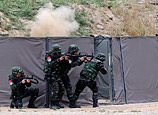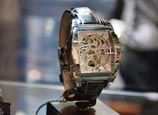
MULTI-FACETED ACHIEVEMENT
Shenzhou-10 is China's first application-oriented space flight.
Wang Zhaoyao said at the press conference that the success of the mission laid a solid foundation for the future construction of China's manned space station.
Compared with its previous mission Shenzhou-9 last year, Shenzhou-10 is no longer experimental but considered an applicable shuttle system for transporting astronauts and supplies to orbiting modules.
The achievements of the Shenzhou-10 mission is multi-faceted.
According to Wang, China has made breakthroughs in mastering extravehicular activities as well as rendezvous and docking technologies.
Moreover, he said, the country has mastered the technologies of controlling and operating the assembled complex of spacecraft and target orbiter, and initially establishing and improving the system for astronauts to stay in orbit.
China has gained benefits in the following three aspects from a series of spacecraft missions, Wang said.
Technically, the country has accumulated a huge amount of experimental data and flight experience.
China also carried out scientific and technical experiments in such fields as space-earth remote sensing, space life science, material science as well as environment survey, Wang said.
The missions have also helped consolidate the basis of China's aerospace technology, elevate the overall capabilities of the nation's space industry, boosted the development of basic science and applied science, and fostered a team of aerospace experts, he added.
In its 15-day journey in space, Shenzhou-10 docked with the orbiting space lab Tiangong-1 twice, once through automatic operation and the other manually.
The astronauts spent 12 days in Tiangong-1, where they conducted space medical experiments, technical tests and delivered a lecture to students on Earth about basic physics principles.
The lecture, given by Wang Yaping aboard the space module, was a highlight of the mission.
It is estimated that more than 60 million students and teachers at about 80,000 middle schools across the country watched the live broadcast of the 40-minute space lecture on television.
During the lecture, Wang introduced the motion in micro-gravity environments and surface tension of liquid in space, with several demonstrations, and answered questions from the students.
The lecture was successful, and some media said that it inspired the hope and passion for science and space among the Chinese youth, Wang Zhaoyao told the press conference.
Rigzin Jigme Doje, a high school freshman in Lhasa, capital of southwest China's Tibet Autonomous Region, said he was most impressed by Wang Yaping's demonstration of the "water ball" that illustrated the surface tension of water in a micro-gravity environment.
He said the lecture had reinforced his dream of becoming a physicist.
The Shenzhou-10 mission was the first high-profile space mission after Xi Jinping took office as China's president in March this year.
On June 24, Xi made a video call to the astronauts, during which he said "the space dream is part of the dream to make China stronger."
"With the development of space programs, the Chinese people will take bigger strides to explore further into space," the president said.
China is the third country after the United States and Russia to acquire the technologies and skills necessary for space rendezvous and docking procedures, as well as supply manpower and materials for an orbiting module via different docking methods.
Previous docking procedures conducted between Shenzhou-type spacecraft and the orbiting space lab included two automated dockings by the unmanned Shenzhou-8 in 2011 and both an automated and manual docking by the manned Shenzhou-9 in 2012.
Tiangong-1 has been in orbit for more than 600 days. The module is considered the first step in building a permanent space station in the future.
Since its first manned space mission in 2003, China has sent ten astronauts and six spacecrafts into space.

















 Wait and See!
Wait and See!
I can catch you, rats


![]()
